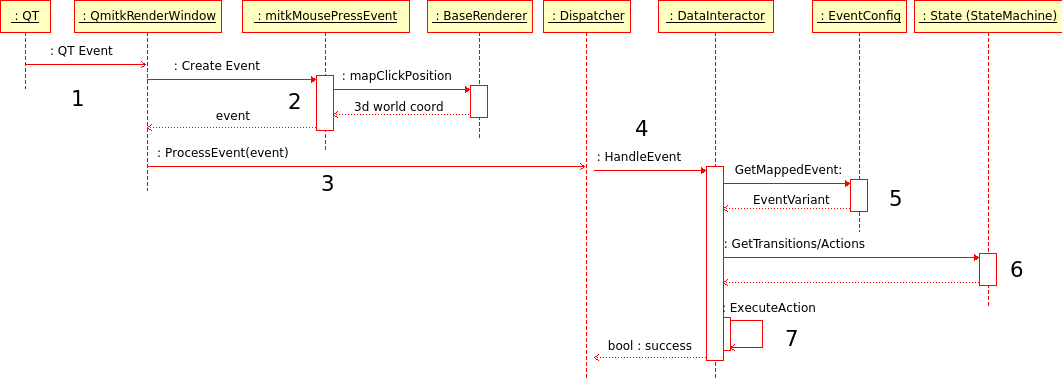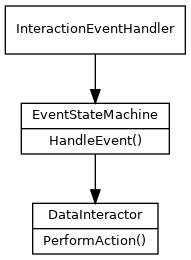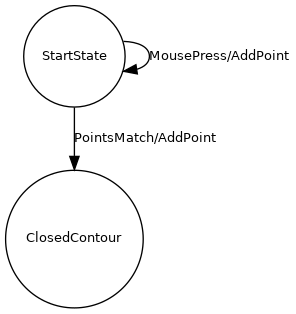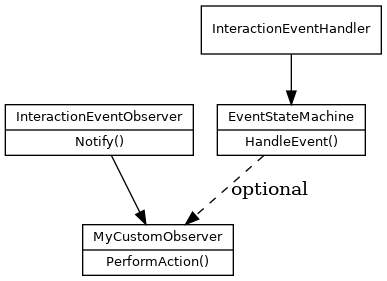Table of Contents
Introduction to Interaction in MITK
Interaction is a very important task in medical image processing software. Therefore MITK provides a special interaction concept that provides the developer with an easy way to develop and maintain user interaction separately from the algorithms processing the input. This allows e.g. for common interaction schemes to be re-used in different contexts.
The core of the interaction concept is based on entities called DataInteractors that listen for certain pre-defined events and execute actions when such an event is triggered.
In the following the different components of the interaction concept are explained. First a a high-level overview about how the different components interact is given, then some parts are explained in more detail.
Topics related to interaction - further information:
See the Interaction Concept Implementation page for a more technical explanation.
Consult Step 01 - How to use an existing DataInteractor in your Module/Plugin/... for usage information.
See How to implement a new DataInteractor for an example on how to implement a new mitk::DataInteractor
for information about how to create new events refer to ImplementNewEventsPage.
The documentation of the deprecated former concept can be found at Interaction and Undo/Redo Concepts.
For a list of changes with respect to the previous interaction concept please refer to the Migration Guide to new Interaction Concept
Event Handling & GUI Toolkit Abstraction
The following sequence diagram gives an exemplary overview of the process from creating an event until executing an action in the mitk::DataInteractor. This diagram assumes the usage of the Qt framework, but also shows that the interaction concept itself is implemented independent of any specific graphical user interface toolkit.

- a user event is triggered and send to MITK
- this layer serves as an adapter from the GUI toolkit (here Qt) events to MITK internal events (later referred to as InteractionEvents).
- once the event is adapted it is send to a mitk::Dispatcher, which is linked to a render window, to be handled.
- on the mitk::Dispatcher level all objects are known that can react to incoming events (mitk::DataInteractor and mitk::InteractionEventObserver instances)
- a mitk::DataInteractor is offered an event and checks its mitk::EventConfig object, which returns if a variant of this event has been defined for this DataInteractor.
- if the DataInteractor has a variant for the event, it consults its state machine to check if the input can be handled in the current state
- the actions associated with a state change (transition) are executed and the event is successfully handled.
Events
Events can describe any sort of user input, such as key strokes, mouse clicks or touch gestures. These events are mapped from an UI framework like Qt to an MITK internal representation and send to the mitk::Dispatcher which in turn deals with further processing of the event. These events are not limited to classical input devices but can be extended at will, by introducing new classes which e.g. describe events from tracking devices, etc. Refer to What needs to be done to implement a new event? to see how new events and thereby input devices can be integrated. For an overview of available Events see mitk::InteractionEvent, for on overview of parameters see the Interaction Concept Implementation.
InteractionEventHandler
Is the term describing objects in general that can handle events. These objects can be divided into two groups, namely DataInteractors and mitk::InteractionEventObserver. Their difference is that mitk::DataInteractor instances are linked with a mitk::DataNode which they manipulate, whereas mitk::InteractionEventObserver instances do not have a mitk::DataNode and therefore are not supposed to manipulate any data.

DataInteractors
DataInteractors are specialized mitk::InteractionEventHandler which handle events for one specific DataNode. They are implemented following a concept called state machines (see e.g. Wikipedia ).
StateMachines
A specific events action is usually desired to depend on the content of the data object and the state of the interaction. For example when adding a line by clicking with the mouse, the first two clicks are supposed to add a point. But the second click should additionally finish the interaction and a subsequent third click should be ignored. State machines provide a great way to model such interaction in which the same user interaction can trigger different actions depending on the current state. Therefore DataInteractors work with so called state machine patterns. The basic idea here is that each interaction can be described by states and transitions which in turn trigger actions. These patterns define a workflow and different patterns can be applied to the same mitk::DataInteractor and cause this mitk::DataInteractor to perform different user interactions. This principle is best described by an example. Imagine a mitk::DataInteractor with the functionality (1) to add Points at a given mouse position and connect them by a line and (2) check if two points are on the same position. Using this mitk::DataInteractor, different mitk::StateMachine patterns/descriptions can be given which each cause the mitk::DataInteractor to perform different interaction schemes.
State machine pattern 1: We want the user to draw a line. A simple state machine could express this by three states like this:

With each MousePress event the AddPoint function is called and adds a point at the mouse position, unless two points already exist.
State machine pattern 2: The same mitk::DataInteractor can also operate after the following state machine, which models the interaction to input a closed contour. The mitk::DataInteractor can detect an AddPoint event on an already existing point and will trigger a PointsMatch event.

In this way state machines provide both, a nice and structured way to represent interaction tasks and description of the interaction which is separated from the code. One DataInteractor can be re-used for different tasks by simply exchanging the state machine pattern. These patterns are described in XML files.
Definition of a State Machine
The definition is made up out of four components.
- States - represent the current status of the interaction
- Transitions - describe the events needed to change from one state to another
- Conditions - are executed, before a transition is taken
- Actions - are executed, when a transition is taken and conditions for that transition have passed
Each state machine needs exactly one designated start state into which the state machine is set in the beginning.
An example of a state machine describing the interaction of example 2 looks like this:
Example 1: State machine pattern, that describes adding points to a contour until the PointsMatch event is triggered.
For a more detailed description of state machine patterns see here.
InteractionEventObserver
mitk::InteractionEventObserver instances are objects which will receive all user input and are intended for observation only, they should never modify any DataNodes. For mitk::InteractionEventObserver it is optional to use the state machine functionality, the default is without. How to use the state machine functionality is described in the documentation of mitk::InteractionEventObserver::Notify.

Configuration
In a lot of cases it is preferable to implement interactions independent of a specific event (e.g. left click with mouse), such that it is possible to easily change this. This is achieved through configuration of InteractionEventHandlers. This allows to change the behavior at runtime. The mitk::InteractionEventHandler class provides an interface to easily modify the user input that triggers an action by loading a different configuration. This allows to implement user-specific behavior of the software on an abstract level and to switch it at runtime. This is achieved through XML files describing a configuration. These files can be loaded by the mitk::InteractionEventHandler and will lead to an internal mapping from specific user input to an abstract description of the event given in the config file.
In order to do this we distinguish between a specific event and an event variant. A specific event is described by its event class, which determines the category of an event, e.g. the class mitk::MousePressEvent, and its parameter which make this event unique, e.g. LeftMouseButton pressed and no modifier keys pressed. The event variant is a name that is assigned to a specific event, and to which an mitk::InteractionEventHandler listens.
To illustrate this, an example is given here for two different configuration files. We assume that a mitk::InteractionEventHandler listens to the event variant 'AddPoint', two possible config files could then look like this:
Example 2: Event description of a left click with the mouse
and
Example 3: Event description of a left click with the mouse while pressing the shift-key
If the mitk::InteractionEventHandler is loaded with the first configuration the event variant 'MousePress' is triggered when the user performs a mouse click, while when the second configuration is loaded 'MousePress' is triggered when the user performs a right click while pressing the shift button. In this way all objects derived from mitk::InteractionEventHandler can be configured. For a detailed description about how to create the XML file see the Interaction Concept Implementation page.
Dispatcher
Instances of mitk::Dispatcher receive all events and distribute them to their related mitk::DataInteractor instances. This is done by ordering the DataInteractors according to the layer of their mitk::DataNode in descending order. Then the event is offered to the first mitk::DataInteractor, which in turn checks if it can handle the event. This is done for each mitk::DataInteractor until the first processes the event, after this the other DataInteractors are skipped and all InteractionEventObservers are notified.
Examples
Examples can be found at Interaction Related Examples in MITK
